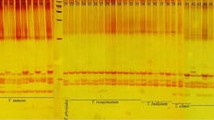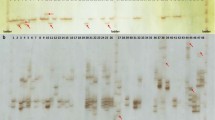Abstract
Microsatellite marker transfer across species in the dioecious genus Actinidia (kiwifruit) could offer an efficient and time-effective technique for use during trait transfer for vine and fruit improvement in breeding programmes. We evaluated the cross-species amplification of 20 EST-derived microsatellite markers that were fully informative in an Actinidia chinensis mapping family. We tested all 20 markers on 120 genotypes belonging to 21 species, 5 with varieties and/or chromosome races. These 26 taxa included 16 diploids, 7 tetraploids, 2 hexaploids and 1 octaploid, and represented all four taxonomic sections in the genus. All 20 markers showed some level of cross-species amplification. The most successful marker amplified in all genotypes from all species from all sections of the genus, the least successful amplified fragments only in A. chinensis and A. deliciosa. One species, A. glaucophylla, failed to amplify with all but 2 markers. PIC (Polymorphism information content) values were high, with 14 of 17 markers recording values of 0.90 and above. Sequence data demonstrated the presence of the microsatellite in all the amplified products. Sequence homology was less 5′ of the microsatellite and increased toward the start codon of the translated region of the EST from which the marker was derived. The data confirm that EST-derived microsatellite markers from Actinidia species show cross-species amplification with high levels of polymorphism which could make them useful markers in breeding programmes.

Similar content being viewed by others
References
Angers B, Bernatchez L (1997) Complex evolution of a salmonid microsatellite locus and its consequences in inferring allelic divergence from size information. Mol Biol Evol 14(3):230–238
Blanc G, Wolfe KH (2004) Functional divergence of duplicated genes formed by polyploidy during Arabidopsis evolution. Plant Cell 16:1679–1691
Botstein D, White RL, Skalnick MH, Davies RW (1980) Construction of a genetic linkage map in man using restriction fragment length polymorphism. Am J Hum Genet 32:314–331
Brook JD, McCurrach ME, Harley HG, Buckler AJ, Church D, Aburatani H, Hunter K, Stanton VP, Thirion JP, Hudson T (1992) Molecular basis of myotonic dystrophy: expansion of a trinucleotide (CTG) repeat at the 3′ end of a transcript encoding a protein kinase family member. Cell 68:799–808
Buteler MI, Jarret RL, LaBonte DR (1999) Sequence characterization of microsatellites in diploid and polyploid Ipomoea. Theor Appl Genet 99:123–132
Byrne M, Marquez-Garcia MI, Uren T, Smith DS, Moran GF (1996) Conservation and genetic diversity of microsatellite loci in the genus Eucalyptus. Aust J Bot 44:331–341
Cipriani G, Lot G, Huang WG, Marrazzo MT, Peterlunger E, Testolin R (1999) AC/GT and AG/CT microsatellite repeats in peach [Prunus persica (L) Batsch]: isolation, characterisation and cross-species amplification in Prunus. Theor Appl Genet 99:65–72
Colson I, Goldstein DB (1999) Evidence for complex mutations at microsatellite loci in Drosophila. Genetics 152:617–627
Cordeiro GM, Casu R, McIntyre CL, Manners JM, Henry RJ (2001) Microsatellite markers from sugarcane (Saccharum spp.) ESTs cross transferable to erianthus and sorghum. Plant Sci 160:1115–1123
Di Gaspero G, Peterlunger E, Testolin R, Edwards KJ, Cipriani G (2000) Conservation of microsatellite loci within the genus Vitis. Theor Appl Genet 101:301–308
Echt CS, Vendramin GG, Nelson CD, Marquardt P (1999) Microsatellite DNA as shared genetic markers among conifer species. Can J For Res 29:365–371
Eckardt NA (2004) Two genomes are better than one: widespread paleopolyploidy in plants and evolutionary effects. Plant Cell 16:1647–1649
Ellegren H, Primmer CR, Sheldon BC (1995) Microsatellite evolution—directionality or bias. Nature Genet 11:360–362
Ferguson AR, O'Brien IEW, Yan GJ (1997) Ploidy in Actinidia Acta Hort 444:67–71
Fraser LG, Harvey CF, Crowhurst RN, De Silva HN (2004) EST-derived microsatellites from Actinidia species and their potential for mapping. Theor Appl Genet 108:1010–1016
Fraser LG, Harvey CF, Gill GP (2001) Application of microsatellite-based DNA profiling in Actinidia species. Acta Hort 546:401–405
Fridman E, Pleban T, Zamir D (2000) A recombination hotspot delimits a wild-species quantitative trait locus for tomato sugar content to 484 bp within an invertase gene. Proc Natl Acad Sci USA 97:4718–4723
Fridman E, Zamir D (2003) Functional divergence of a syntenic invertase gene family in tomato, potato, and Arabidopsis. Plant Physiol 131:603–609
Gebhardt C, Walkemeier B, Henselewski H, Barakat A, Delseny M, Stüber K (2003) Comparative mapping between potato (Solanum tuberosum) and Arabidopsis thaliana reveals structurally conserved domains and ancient duplications in the potato genome. Plant J 34:529–541
Gill GP, Harvey CF, Gardner RC, Fraser LG (1998) Development of sex-linked PCR markers for gender identification in Actinidia. Theor Appl Genet 97:439–445
Grant D, Cregan P, Shoemaker RC (2000) Genome organization in dicots: Genome duplication in Arabidopsis and synteny between soybean and Arabidopsis. Proc Natl Acad Sci USA 97:4168–4173
Grimaldi M-C, Crouau-Roy B (1997) Microsatellite allelic homoplasy due to variable flanking sequences. J Mol Evol 44:336–340
González-Martínez SC, Robledo-Arnuncio JJ, Collada C, Díaz A, Williams CG, Alía R, Cervera MT (2004) Cross-amplification and sequence variation of microsatellite loci in Eurasian hard pines. Theor Appl Genet 109:103–111
Gupta PK, Rustgi S, Sharma S, Singh R, Kumar N, Balyan HS (2003) Transferable EST-SSR markers for the study of polymorphism and genetic diversity in bread wheat. Mol Genet Genomics 270:315–323
Hempel K, Peakall R (2003) Cross-species amplification from crop soybean Glycine max provides informative microsatellite markers for the study of inbreeding wild relatives. Genome 46:382–393
Huang WG, Cipriani G, Morgante M, Testolin R (1998) Microsatellite DNA in Actinidia chinensis: isolation, characterisation, and homology in related species. Theor Appl Genet 97:1269–1278
Isagi Y, Suhandono S (1997) PCR primers amplifying microsatellite loci of Quercus myrsinifolia Blume and their conservation between oak species. Mol Ecol 6:897–899
Kijas JMH, Fowler JCS, Thomas MR (1995) An evaluation of sequence tagged microsatellite site markers for genetic analysis within Citrus and related species. Genome 38:349–355
Kramer EM, Jaramillo MA, Di Stilio VS (2004) Patterns of gene duplication and functional evolution during the diversification of the AGAMOUS subfamily of MADS box genes in angiosperms. Genetics 166:1011–1023
Kuleung C, Baenziger PS, Dweikat I (2004) Transferability of SSR markers among wheat, rye, and triticale. Theor Appl Genet 108:1147–1150
Liewlaksaneeyanawin C, Ritland CE, El-Kassaby YA, Ritland K (2004) Single-copy, species-transferable microsatellite markers developed from loblolly pine ESTs. Theor Appl Genet 109:361–369
Matsuoka Y, Mitchell SE, Kresovich S, Goodman M, Doebley J (2002) Microsatellites in Zea—variability, patterns of mutations, and use for evolutionary studies. Theor Appl Genet 104:436–450
McNeilage MA, Considine JA (1989) Chromosome studies in some Actinidia taxa and implications for breeding. NZ J Bot 27:71–81
Morgante M, Olivieri AM (1993) PCR-amplified microsatellites as markers in plant genetics. Plant Journal 3:175–182
Otto SP, Whitton J (2000) Polyploid incidence and evolution. Ann. Rev Genet 34:401–437
Peakall R, Gilmore S, Keys W, Morgante M, Rafalski A (1998) Cross-species amplification of soybean (Glycine max) simple sequence repeats (SSRs) within the genus and other legume genera: implications for the transferability of SSRs in plants. Mol Biol Evol 15:1275–1287
Pierantoni L, Cho KH, Shin IS, Chiodini R, Tartarini S, Dondini L, Kang SJ, Sansavini S (2004) Characterisation and transferability of apple SSRs to two European pear F-1 populations. Theor Appl Genet 109:1519–1524
Rongwen J, Akkaya MS, Baghwat AA, Lavi U, Cregan PB (1995) The use of microsatellite DNA markers for soybean genotype identification. Theor Appl Genet 90:43–48
Schlotterer C, Tautz D (1992) Slippage synthesis of simple sequence DNA. Nucleic Acids Res 20:211–215
Scott K (2001) Microsatellites derived from ESTs and their comparison with those derived from by other methods. In: RJ Henry (ed) Plant genotyping: the DNA fingerprinting of plants. CABI, New York, pp 225–237
Stephens SG (1951) Possible significance of duplication in evolution. Adv Genet 4:247–265
Valdes AM, Slatkin M, Freimer NB (1993) Allele frequencies at microsatellite loci: the stepwise mutation model revisited. Genome 133:737–749
Vincent JB, Paterson AD, Strong E, Petronis A, Kennedy JL (2000) The unstable trinucleotide repeat story of major psychosis. Am J Med Genet 97:77–97
Weising K, Fung RWM, Keeling DJ, Atkinson RG, Gardner RC (1996) Characterisation of microsatellites from Actinidia chinensis. Mol Breed 2:117–131
Wendel JF (2000) Genome evolution in polyploids. Plant Mol Biol 42:225–249
Westman AL, Kresovich S (1998) The potential for cross-taxa simple-sequence repeat (SSR) amplification between Arabidopsis thaliana L. and crop brassicas. Theor Appl Genet 96:272–281
Wünsch A, Hormaza JI (2002) Molecular characterisation of sweet cherry (Prunus avium L.) genotypes using peach Prunus persica (L.) Batsch SSR sequences. Heredity 89:56–63
Acknowledgements
We thank Hanna-Mari Tervo and Zhening Zhang for excellent technical assistance, and Bhawana Nain for sequencing data. This research was partially funded by the New Zealand Foundation for Research, Science and Technology (CO6X0213) and by the HortResearch Royalty Fund.
Author information
Authors and Affiliations
Corresponding author
Additional information
Communicated by I. Paran
Rights and permissions
About this article
Cite this article
Fraser, L., McNeilage, M., Tsang, G. et al. Cross-species amplification of microsatellite loci within the dioecious, polyploid genus Actinidia (Actinidiaceae). Theor Appl Genet 112, 149–157 (2005). https://doi.org/10.1007/s00122-005-0117-x
Received:
Accepted:
Published:
Issue Date:
DOI: https://doi.org/10.1007/s00122-005-0117-x




